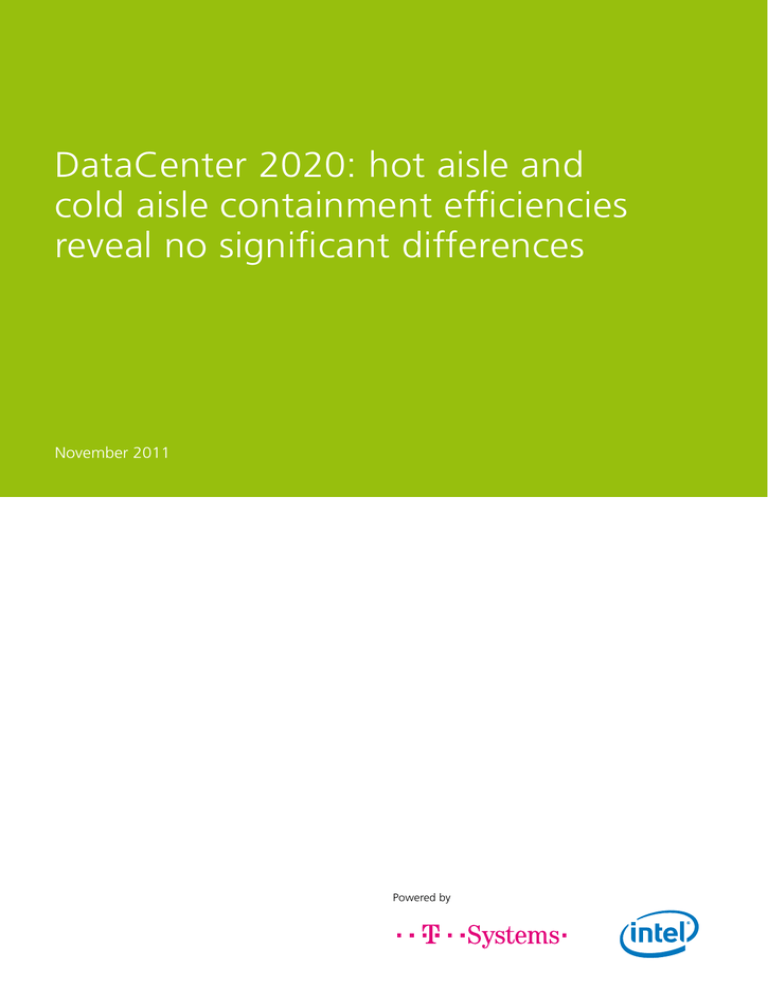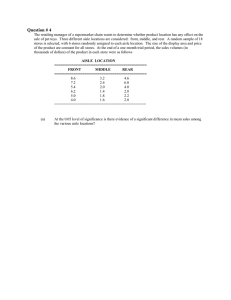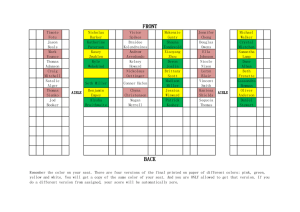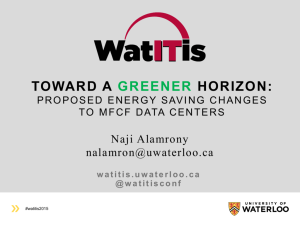
DataCenter 2020: hot aisle and
cold aisle containment efficiencies
reveal no significant differences
November 2011
Powered by
WHITE PAPER: DataCenter 2020
DataCenter 2020: hot aisle and
cold aisle containment efficiencies
reveal no significant differences
The DataCenter 2020 is a joint T-Systems and Intel data center
test laboratory in the Munichbased Euroindustriepark. The two
companies are working to determine methods by which energy
efficiency and operations in existing data centers can be optimized. Based on this work and the knowledge derived, the team
is also developing a model of the data center of the future. So
far, the researchers have demonstrated improved energy efficiency through the consistent separation of cold and hot air and
by raising the supply air temperature and provisioning to a higher
energy density in the rack. A substantial proportion of the lower
energy consumption is due to being able to optimize the air flow
rate through variable speed fans in the cooling units, a capability
derived from the cold-aisle containment. In this, the third phase
of research, the team has repeated the efforts outlined in the
first two white papers, with a hot-aisle containment to compare
and contrast it with the improvements found with the cold aisle
containment.
Review: The results to date
In the first phase of the optimization the researchers from
T-Systems and Intel reduced data center energy consumption by
two simple means:
1. The strict separation of cold and hot air in the raised floor and
the cold aisle containment lead to optimized air ducting and
minimization of leakage and airflow mixing. This can also reduce the fan speed of the circulating air cooling units.
2. Raising the supply air temperature delivered under the raised
floor (T1) along with a coincident increase of the chilled water
temperature. This minimizes the hours required for cooling
by the chillers and extends the hours available for indirect
free cooling. The PUE result could be further improved if the
cooling air temperature was increased in accordance with the
upper limit of the ASHRAE recommendations to provide a
computer inlet temperature (TA) of 27 °C.
With these initial measures, the researchers succeeded in reducing the DataCenter 2020 PUE ratio from 1.8 to 1.4, with the
computer inlet temperature remaining unchanged at 22 °C. The
„Power Usage Effectiveness“ (PUE) value measures the efficiency
of energy use in the Data Center infrastructure. It shows how
much energy used is actually consumed by the IT equipment versus the data center support equipment.
PUE is the ratio of the total energy used in the data center (Total
Facility Power Consumption) and total energy consumption for
IT Equipment (IT Equipment Power Consumption). The PUE is a
good metric for the energy consumption of the non-IT-related infrastructure (power distribution, airflow, cooling, facility security
etc.) supporting the IT equipment. PUE, however, does not offer
any conclusions about the energy efficiency of IT equipment or
the overall efficiency of the data center itself.
WHITE PAPER: DataCenter 2020
The following figure depicts the changes resulting from reducing
the leakage in the raised floor and the cold aisle containment, and
the computer inlet temperature (TA) remains constant at 22 °C.
By sealing the raised floor and providing a clear separation of
cold and warm air we increased the pressure in the raised floor
and increased the ΔT in the CRAH cooling coil (ΔT = difference
between return air and supply air temperature) from 6 to 17 °C.
This means that the CRAH will operate much more efficiently
than before. Additionally, the fan speed was reduced to 30 percent (previously at 100 percent). Because of the fan power laws,
this means that the fan motor consumes about 90 percent less
energy. The air flow also slows down due to the reduced fan
speed. Since the air then absorbs more heat, the return air temperature (T2) is increased from 24 °C to 38 °C. Also, the inlet
temperature (T1) under the raised floor can be increased from
18 °C to 21 °C. Since the computer inlet temperature TA is still at
22 °C, a very small temperature gradient between the raised floor
and server inlet temperature is achieved. In the next step (see
White Paper: Delivering high density in the Data Center; efficiently
and reliably), the DataCenter 2020 team increased the IT load to
22kW/rack to see how the PUE or the efficiency of data center
infrastructure may depend on the energy density. The computer’s
inlet temperature (TA) remained constant still at 22 °C.
They chose two scenarios:
In the first scenario, they used a single CRAH. The external circulation water supply temperature was kept at 8 °C. The resultant PUE decreased at an energy density of 22 kW/rack down
to 1.32.
In the second scenario, they established an energy density of
10kW/rack with two CRAHs operating with a water supply temperature of 16 °C. The two CRAH fan speeds were reduced
accordingly. With only one half of the airflow needed with two
CRAHs operational, only one quarter of the power was needed
in each unit as compared with single unit operation. The higher water-supply temperature also reduces the use of chillers.
This also allowed a greater use of indirect free cooling for more
hours per year, which also reduces the total energy expenditure.
This allowed the team to further reduce the PUE value to 1.23.
T2 = 24°C
Air short circuit
Hot aisle
Cold aisle
Hot aisle
∆T=6K
(Q=cv x m x dT)
TR = 24°C
CRAC Unit
Fan 100%
Leakage
Leakage
Raised floor
T1 = 18°C
p = 16pa
WHITE PAPER: DataCenter 2020
Overall, it was found that energy densities well in excess of 20
kW/rack could be supported safely and with good availability
using standard technology in conventional CRAH based cooling.
The structured use of the optimization steps outlined in our first
white paper remains the best path. The cold aisle containment
becomes more important at higher energy densities and plays
a more important supporting role in failure scenarios. The measurements showed that, with separation of cold and warm air
(leakage sealing, cold aisle containment), the energy density or IT
load per rack can increase by approximately three times - and yet
with the same reliability as in the case without containment. In
addition, we benefited from a nearly three-fold higher run time
in the event of complete failure of the air supply.
New measures: hot aisle containment
In the next step, the researchers conducted the same measurements, but this time using a hot-aisle containment to examine
the preferred performance in comparison to standard configurations (hot aisle/cold aisle) and to compare it with the cold-aisle
containment. Different opinions existed in the market on each
configuration’s efficiency advantages, but nothing had been
established empirically. Regardless of the selected enclosure
type, if the servers are operated the same, with the same inlet
temperature and the airflow path is controlled, the energy consumption and the amount of dissipated heat to be cooled are
identical in both systems. For the measurements made with coldaisle containment, the CRAH operated most efficiently with a
temperature difference ΔT of 17 °C (air temperature 38 °C, air
temperature 21 °C).
T2 =38°C
Cold aisle
Hot aisle
Hot aisle
∆T = 17K
(∆Q=cv x m x dT)
TA =2 2 °C
CRAC Unit
Fan 30%
Raised floor
T1 =21°C
p = 4pa
21°C : 70°F
22°C : 72°F
38°C : 100°F
WHITE PAPER: DataCenter 2020
In the hot-aisle containment, the warm exhaust air from the
servers is enclosed and routed directly to the CRAH; the space
of the data center is the cold aisle. Since the CRAH must provide cold air into a wider area with higher air volume leads the
following hypothesis has been offered by others: the hot aisle
containment requires a higher fan speed than the cold aisle containment. On the other hand, it has also been proposed that the
hot-aisle containment would offer advantages in the CRAH’s ΔT
(higher efficiency), since the heat or the warm air generated by
the servers is directed through a duct directly to the cooling coil
of the CRAH. This warm air is better insulated, air turbulence
and mixing reduced, and heat moves directly to the cooler with
no losses to any ambient cooling.
This raises the question: are these effects real? Are these the
same effects, but just in different sections of each containment
scheme? Which system is more efficient?
T2 ( °C)
Cold aisle
Hot aisle
Hot aisle
∆T = T2 - T1
(∆Q=cv x m x dT)
TA (° C)
CRAC Unit
Fan
Raised floor
T1 ( °C)
p ( pa)
T2 ( °C)
Hot aisle
Cold aisle
Cold aisle
∆T = T2 - T1
(∆Q=cv x m x dT)
TA (° C)
CRAC Unit
Fan
Raised floor
T1 ( °C)
p ( pa)
WHITE PAPER: DataCenter 2020
Basically, three parameters are crucial for the cooling function:
1. First there is the cooling coil of the CRAH, which brings in
the warm air and is cooled by cold water as it flows through.
The higher the ΔT (= difference between return air and chilled
water supply) the better.
2. Secondly, the fan of the CRAH, which defines the flow rate
in the data center. Air velocities that are too high can create
poor airflow management and even preclude proper distribution into the rack inlets. Further excessive pressure in the cold
aisle may result in over-pressurization and blow through the
servers, overspinning, with possible detrimental effects on the
server fans.
3. Thirdly, airflow management in the room, optimizing airflow
under the raised floor, control of flow into the containment
and preventing air leakage.
If all of the above-mentioned three parameters are optimized for
each case, there should be no differences in the cold aisle and
hot aisle containment, since the amount of heat is the same as
is the energy used to remove it. This was the assumption of the
technical leads in the DataCenter 2020. The remainder of this
white paper discusses whether the measurements confirm this
hypothesis.
Response Time (mm:ss)
30:00
25:00
20:00
15:00
typ. UPS autonomic time
10:00
05:00
00:00
5,5
9,8
Density [kW/rack]
hot aisle
cold aisle
no enclosure
17,5
Differences in availability and fan speed,
but no differences in PUE
Firstly, the team explored the optimal ratio of energy density
and reliability. To do this they recorded temperatures across the
data center during a cooling system outage. This was done with
different IT densities as well as different spatial configurations.
The baseline operation in the DataCenter 2020 was with an inlet
temperature to the IT of 22C. The servers deployed (and typical
of most IT) had an upper allowable inlet temperature of 35C. The
manufacturer typically guarantees operation of the equipment up
to that point. The cooling systems were failed with a simulated
power outage. Generally the servers will run based on UPS backup. The team’s experience has been that data centers typically
have a 12-minute UPS capability for the IT equipment. By that
time it is typical that backup generators will have come online
and will be supplying power to the IT and the cooling system,
which will have restarted within this window.
The emergency generators and chillers require a certain amount
of time to restart before cooling is returned to the data center to
allow continued operation of the IT equipment. The team’s goal
was to investigate in the three configurations (hot aisle containment, cold aisle containment, and hot/cold aisle arrangements)
at a range of power densities per rack, how long before the inlet
temperature of the IT equipment reached the upper limit and
risked failure of the servers due to overheating (> 35 °C inlet
temperature).
Figure 5 shows that there are definite advantages for hot and
cold aisle containment. The low-density racks, particularly those
in the hot aisle containment, have far more time before failure
from high temperatures. The reason is the large volume of cool
air contained in the room. Note that both containment systems
have marked advantages as compared with the no-containment
system. It has been often suggested, and now shown to be suggested incorrectly, that an open system would allow a longer
time before failure. Instead, the lack of containment allows server
air recirculation very quickly. At high energy density in the rack
of 17.5 kW/rack, the differences appear to be rather small with
slight advantages for the cold aisle containment, most likely due
to the higher volume of total airflow movement and the cold aisle
ability to use the larger high ceiling volume as a heat sink. While
the two systems behave differently depending on the energy
density in the rack, both cold aisle and hot aisle containments
offer greater advantages compared with the scenario without
containment. From Figure 5 we see that in the particular case
of a rack density of 10kW/rack, both containment systems provide more cooling time than the common IT UPS (>12 minutes),
if the cooling capability has not been restored in this time, the
IT equipment will be shutting down due to lack of further UPS
capability and cooling not required anyway. In no case (rack density) did the open data center provide the time needed to support
our target of 12 minutes. Contrary to initial fears, containment
systems actually increase server availability as compared with
other room layouts.
WHITE PAPER: DataCenter 2020
22°C Server Inlet Temperature – 14°C Water Supply Temperature
60
Fan (%)
50
40
30
20
5,5
hot aisle
cold aisle
7,5
9,8
12
15
17,5
22
Density [kW/rack]
Even when we are looking at ΔT in the CRAH units – within
narrow limits – the differences between the two containment
systems exist. For lower and higher energy densities, the cold aisle
containment seems to have a slight benefit. However, due to the
small differences, our conclusion above is that the differences
are slight and most likely site-specific related to the exact airflow
paths, so there is no consequential difference in efficiency.
22°C Server Inlet Temperature – 14°C Water Supply Temperature
22K
20K
18K
ΔT
The same applies to the fan speed in the CRAH, which is already optimized for energy efficiency and running at less than 50
percent. Thus, the bulk of the energy efficiency savings from the
CRAH (> 85% energy savings) has already been achieved. Figure
6 also shows other different behaviors. At a lower energy density
in the rack the cold aisle containment allowed a lower fan speed,
while by increasing the energy density, the lower fan speed was
achieved with the hot-aisle containment. The notable jump is explained by the required use of a second circulation cooling device
from an energy density of 10kW/rack and above which the airflow dynamics shifted. The team believes that the differences are
specific to the system and the site and the resistance of flow in
the particular ducting and underfloor in the DC2020, and that
these results could well be reversed in a different facility. But in
any case, the differences in the optimized fan speeds are extremely low and likely below the detection limit in the electricity bill.
16K
14K
12K
10K
5,5
hot aisle
cold aisle
7,5
9,8
12
15
17,5
22
Density [kW/rack]
22°C Server Inlet Temperature – 14°C Water Supply Temperature
1,45
1,4
PUE
1,35
1,3
1,25
1,2
1,15
5,5
hot aisle
cold aisle
7,5
10
12
Density [kW/rack]
15
17
22
In summary, Figure 8 confirms the hypothesis of the researchers
at the DataCenter 2020 that there are no differences when operating with optimized parameters for the cold aisle and hot aisle
containment, since the amount of heat is always identical. Because there are only minor differences in the value of „Power
Usage Effectiveness“ (PUE), which measures the efficiency of the
infrastructure’s energy, we take these to be within the measurement tolerance. It is important that the same optimization methodology be consistently applied in both systems; that is, eliminate leakage, separate hot and cold air and eventually reduce the
fan speed of the recirculation cooling unit. Differences may exist
in efficiency if these are not consistently applied. However, the
energy efficiency has not then been optimized and we would not
expect to be able to compare the results.
WHITE PAPER: DataCenter 2020
Criteria for selection of the system
Once it is seen that there are no differences in cold and aisle
containment systems relating to energy efficiency, the choice of
which to use becomes one of an operational or space architectural view. A look at the advantages and disadvantages of the
cold aisle and hot aisle containment systems will make the system
choice easier.
The cold aisle containment system can separate cold air and warm
air from each other, without major modification of the server
room. This may be as simple as a false ceiling over the racks and
doors at the ends of rows. It can also be done with a low ceiling height. Gas-based fire extinguishing systems can also be used
effectively as the quenching gas can flow freely through the
raised floor and into the containment. However, the down side
of the cold aisle containment is that employees must work in the
open warm space which could be about 45 °C or warmer, even
though the cold air supplied to the IT equipment continues to be
optimal. In addition, a raised floor for air circulation is typically
needed to transport cool air into the cold aisle.
As with the cold aisle containment, the hot aisle containment also
separates the cold air and warm air from each other. The main
advantage for the hot-aisle containment is for personnel. The hot
aisle containment creates a pleasant working atmosphere for personnel as they walk into a cool room, (even if much of the cabling
work is still in the hot aisle). In addition, a hot-aisle containment
structure can be integrated into an existing space in order to
eliminate „hot spots“ without putting a burden on the remaining
room environment with excess heat re-distribution. In principle,
from an airflow perspective, there is no need for a raised floor.
They are well suited to new construction. On the down side there
are the possible investments required in the reconstruction of the
gas extinguishing system, and additional structures needed for
the air ducting. If there is no raised floor, all supply lines (power
and network cabling) must be from above. This can lead to interference with the airflow path. Therefore, the design of a data
center with hot-aisle containment may still consider a raised floor
(assuming sufficient building height). In both cases, and with lower
airflow mixing, there will be areas much warmer than in a typical
open data center. Therefore all materials and components must
be verified as suitable for the hottest expected temperatures that
they may be exposed to. The same must be done for the safety
and well-being of the employees. Operating temperatures where
people will be working must be understood and designed for.
Both systems have their advantages and disadvantages, but they
are equally effective at providing efficient well-managed airflow
to the IT equipment. Therefore, the choice depends on the particular requirements and operating conditions and architectural
features of the individual site.
Conclusion
The researchers at the DataCenter 2020 improved the center’s
PUE; with standard equipment and a range of energy efficiency
optimization measures. We achieved a PUE of 1.23 without
changing the environmental conditions for the IT equipment. This
was achieved by a cold or hot-aisle containment program (there
are no efficiency differences between the two), a lower CRAH
fan speed, and a higher energy density in the server rack. The
enclosure of the cold or hot aisles increases the availability and
reliability of the servers. Thus, an enclosure at energy densities of
10 to 17.5 kW/rack can be an interesting alternative and relatively inexpensive compared with a larger UPS for air conditioning,
although still not being able to replace other availability measures
completely.
The best result for PUE was achieved when the team operated
the data center according to the upper limit of the ASHRAE
recommendations, with a computer inlet temperature (TA) of
27 °C. The air temperature below the raised floor (T1) is then at
26 °C. This then allows the water supply from the chiller to rise
to 20 °C. Experience with the CRAH cooling coil has shown that
we needed a water temperature that is usually around 6 °C lower
than the temperature of the air under the floor. The higher water
temperature reduces the time required for cooling using the chillers and extends the amount of operating time for indirect free
cooling by outside air.
Outlook: chiller-less cooling
in favorable climates reduces investment costs
The amount of hours of indirect free cooling with outside air is
dependent on climatic conditions at the location of a data center.
Take, for example Munich, the site of the DataCenter 2020:
providing IT equipment with an inlet temperature of 27 °C requires a raised-floor air temperature of 26 °C, which in turn
means that the cold water supply has to be at around 20 °C.
This water temperature can be achieved comfortably by indirect
free cooling as long as the outside air temperature does not
exceed 20 °C (around 10% of the hours each year in Munich,
see Figure 9). Furthermore, a hybrid dry/wet cooling solution can
achieve such water temperature levels with an outside air temperature of up to 26 °C by utilizing the effect of evaporation of
treated water, a very efficient overall method.
WHITE PAPER: DataCenter 2020
Status Quo
Improvement I
Improvement II
100%
Hybrid Heat
Exchanger “Dry”
90%
3147
80%
5034
70%
60%
Hybrid Heat
Exchanger “Wet”
7146
50%
3683
40%
Chiller
30%
3132
20%
1936
10%
1533
600
87
14°C water supply temperature
20°C water supply temperature
0%
8°C water supply temperature
Figure 9
With a combination of measures like this, the energy-intensive method of compression cooling will be required on only four days
during an average year in Munich, allowing a general rethinking of cooling system philosophies for future data centers.
Profile of the average annual temperature in munich
500
450
400
350
300
250
200
150
100
50
0
34
32
30
28
26
24
22
20
18
16
14
12
10
8
6
4
2
-0
-2
-4
-6
-8
-10 -12 -14 -16 -18 -20 -22 -24
Figure 10
For more information on the DataCenter 2020, see:
www.datacenter2020.com
Copyright © 2010 Intel Corporation and T-Systems International GmbH
All rights reserved.
Powered by





